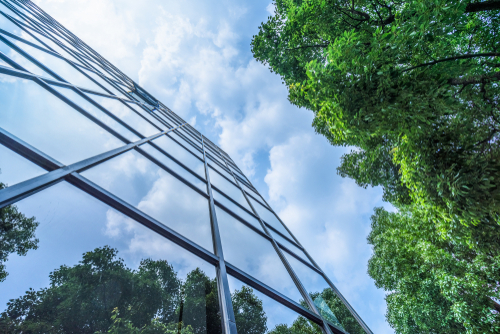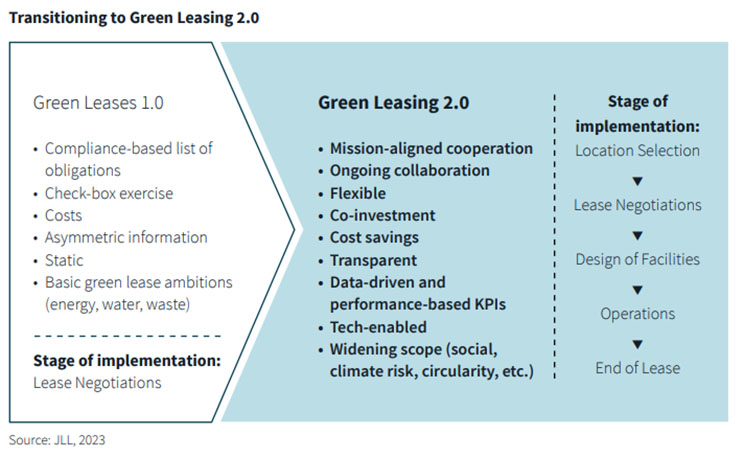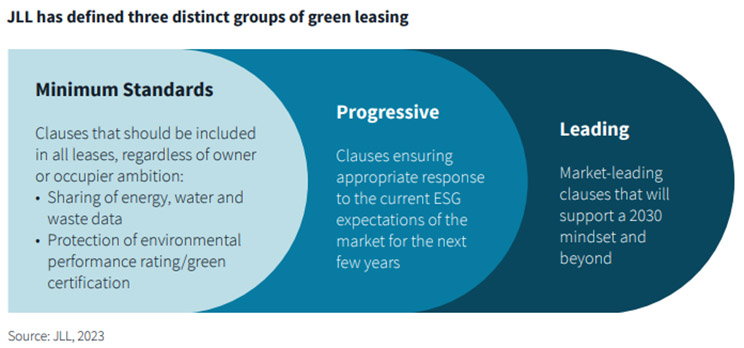As real estate occupiers face increased pressure to lower their carbon footprint, and investors are greening their portfolios, green leases can benefit both landlords and tenants while also serving to decarbonize real estate. JLL’s new Green Leasing 2.0: Bridging the owner-occupier divide to deliver shared ESG value report outlines the considerations building occupiers and owners should include at all stages of the relationship to incorporate sustainability.

The U.S. market could reap $3.3 billion in annual cost savings if every leased office building implemented green leases, as estimated by the Institute for Market Transformation. And, with 1.2 billion square feet of office space and 2.5 billion square feet of industrial space experiencing a lease expiration before 2030 in the U.S. alone, according to JLL research, an emphasis on collaboration and communication will be increasingly important.
JLL’s Decarbonizing the Built Environment research also found 42% of investors and 34% of occupiers already implement green clauses in their current leases, and implementation is set to double with an additional 37% of investors and 40% of occupiers planning to enact green lease clauses by 2025. JLL said integrating an extended vision for decarbonization through the full life cycle of a building’s lease will help both occupiers and owners track toward sustainability goals.

“Amid the current energy crisis and with increased pressure to meet sustainability goals, collaboration between the owner and occupier at an asset level to incorporate energy-efficient solutions is critical. Existing leases, both green and non-green, do not allow this and a new model is needed with increased transparency and data sharing,” said Guy Grainger, JLL global head of sustainability services and ESG. “Green Leasing 2.0 will increase operational efficiency and lower costs will realize the mutual value of greener buildings to all stakeholders.”

With only seven years remaining to halve emissions in the built environment and meet the Paris Agreement scenario, JLL said real estate leaders need to do the following:
Education: Leases are complex legal agreements, and individuals will be reluctant to agree to certain terms without clear understanding and reward. Shared information and communication in the lease process can help bridge the divide between building owners and occupiers to ensure comprehension of lease language and reduce potential emissions, associated costs, and fines.
Engagement: Ongoing engagement and mission-aligned collaboration between owners and occupiers is required through the life of the lease. Clauses that formalize regular points of contact, such as annually, are often the most useful and effective, but engagement should remain flexible.
Shared Equity: Green leases must be equitable forms of contract, including cooperation and cost-sharing clauses between owners and occupiers. Transparency and data-sharing of energy, water, and waste production also supports this practice and are good ways to build trust. JLL said data measurement and sharing is a critical first step to integrate into green leases, more common in countries like Canada, France, and the Netherlands, but in the U.S. and the U.K., some hesitancy remains. With the benefit of this data, owners and occupiers can set measurable goals and keep green leases focused on climate-positive outcomes. By prioritizing equity, both parties mutually benefit economically and sustainably, allowing for better decarbonization solutions, more favorable lease terms, and stronger partnerships.
JLL’s own corporate portfolio, representing 381 sites across 52 countries, integrates sustainability across the entire leasing landscape to deliver on net-zero targets.
Grainger said, “Green leases are an important tool to help us meet our ESG goals with the added bonus of driving efficiency,” said Grainger.
The full report is available for download here.
